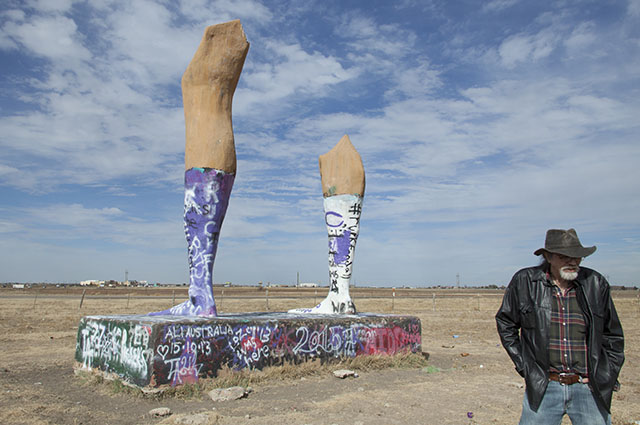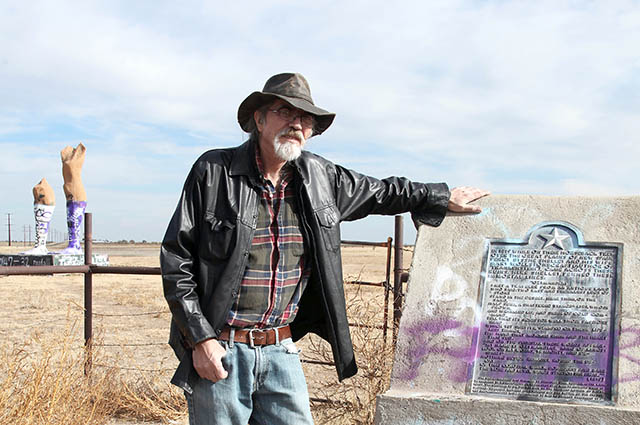Ozymandias: A King, a Poem and a Concrete Statue in a Cow Pasture
By Eva Lorraine Molina
For Reporting Texas
Eleven miles south of Amarillo, just off of Interstate 27, lie the ruins of an ancient monument. Two huge, disembodied legs are all that is left of the statue. At least, that’s what you’re supposed to be fooled into thinking.
The statue actually was built 17 years ago and made to look like the remains of a 4,500-year-old statue of Ramesees II, the pharaoh who filled Egypt’s Valley of Kings with monuments to himself. It is called Ozymandias (which is Ramesses in Greek) and was inspired by Percy Bysshe Shelley’s famous poem of the same name.
Ozymandias was thrust into the spotlight in September when Slate featured the statue in its travel blog, Atlas Obscura. Three days later, the hit TV series “Breaking Bad” aired its “Ozymandias” episode, also inspired by Shelley’s ode. The hashtag Ozymandias trended nationally on Twitter and brought at least some who scrolled through the collection of tweets to Ozymandias in Amarillo.
For some Texans, Amarillo’s Ozymandias, a monument to a poem about the futility of monuments, will likely as not be associated with the fortunes of eccentric millionaire and artist Stanley Marsh 3.
Marsh is famous for commissioning artistic jokes. His puckish purview in the Texas Panhandle was rocked in recent months after 13 men filed lawsuits against him alleging sexual abuse. Marsh’s family has since settled several civil suits out of court. More suits are pending against Marsh, who also faces criminal charges on 14 counts of sex with underage boys.
Marsh’s legal troubles prompted critics to call for the removal of his most famous art installation, Cadillac Ranch — a row of 10 classic Cadillacs, half-buried, nose-down in another one of his pastures near Amarillo. The cries for Cadillac Ranch’s removal died down when it was revealed that Marsh no longer owned the display.
The Ozymandias statue and the land it rests on do belong to the Marsh family, but for the time being at least, no one has called for the legs to be demolished. Wreathed by barbed-wire fencing, the statue has a base 4 feet tall, 10 feet wide and 20 feet long, and supports a left leg rising 24 feet in the air and a right leg that’s 34 feet high.
John Kelso, a humor columnist for the Austin-American Statesman and author of the travel book “Texas Curiosities,” said Marsh’s run-ins with the law “don’t take away from Ozymandias. They don’t take anything away from the art.”
“I think the statue is a welcome change from all the cigar-store wooden Indians and body-shop cowpoke statues that litter the state,” Kelso said. “Maybe the next time Big Tex goes up in flames at the state fair, they can replace him with this lovely objet d’art.”
Marsh gained a reputation as a prankster when he commissioned many of Amarillo’s quirky public art displays, including the Dynamite Museum’s project of mock diamond-shaped traffic signs scattered throughout the city.
“He was entertaining to be around. He was creative. He enjoyed being deprecating and eccentric. He enjoyed putting up funky art because it was fun for him,” Kelso said about Marsh, whom he interviewed for his travel book in 1999.
Ozymandias Reincarnate
In 1994, Marsh approached Lightnin’ McDuff, an Amarillo-based sculptor, with the idea to create a replica of the ruins in Shelley’s poem.
“Ozymandias is one of Stanley Marsh’s favorite poems,” McDuff said, adding that he had been unfamiliar with Shelley’s ode. “After I read it, I thought it was a cool idea to do a sculpture like it was described in the poem.”
“I made a deal where Stanley paid for all the materials and the help, and I got paid wages,” McDuff said. “I did it for the experience and the opportunity. The money was secondary.”
McDuff began the job in early 1994 and, working part-time, completed the statue in 1996, but not without challenges. On windy days, he said, he couldn’t work because the gusts blowing off the prairie were strong enough to blow him off of his scaffold.
Though Ozymandias is made of concrete, McDuff was tasked to make the statue look like it was carved from sandstone, the only large stone available in the Panhandle. “We wanted it to look like it was weathered and old and had been through prairie fires and storms and one thing or another,” McDuff said.
In true prankster fashion, Marsh topped off the installation with a fake historical marker near the roadside viewing area to mislead curious travelers. The text includes three erroneous claims. The first: The legs are the ruins and inspiration for Shelley’s poem – in fact, the poem inspired the statue.
The second: The “shattered visage” Shelley mentions in the poem had been damaged as a casualty of the rivalry between Lubbock and Amarillo. This is not true. McDuff never made a shattered face to accompany the legs.
Finally, the nonexistent visage does not reside in the Amarillo Museum of Natural History because, like the visage, the museum does not exist.
For most of its existence, Ozymandias has been a hidden art display. Travelers seeking quirky roadside attractions have discovered the statue from travel books and pictures on community travel blogs such as RoadsideAmerica.com
Nonetheless, the statue has become an accidental roadside attraction. McDuff said he originally intended to place the statue farther from the road.
“It wasn’t really meant to be so much a tourist attraction, as it’s supposed to be the ruins of an ancient statue,” McDuff said. “If I had understood how much the scale shrinks out there, I probably would have made it three times as big.”
The farther it is from the road, the less likely visitors and vandals would be to hop the barbed-wire fence to get close to the sculpture, which is what they do now. The monument erected as a prank has been plagued by pranksters who, among other indignities, have placed tube socks on its legs and daubed nail polish on its feet.
Since he brought Ozymandias to life, McDuff has remained a prominent figure in the Amarillo art community.
“McDuff is wildly imaginative with a keen sense of humor. He is very active in the Amarillo art scene and has been for many years, and enjoys great popularity in the Amarillo area,” said Alex Gregory, interim curator at the Amarillo Museum of Art.
Thinking back on his creation, McDuff said, “I made a good piece.”
Not unlike Ramesses II filling the Valley of Kings with monuments to himself perhaps, Marsh filled Amarillo with monuments to his humor. Now Ozymandias’ legs stand as testament to an artistic humor empire fallen on hard times.


